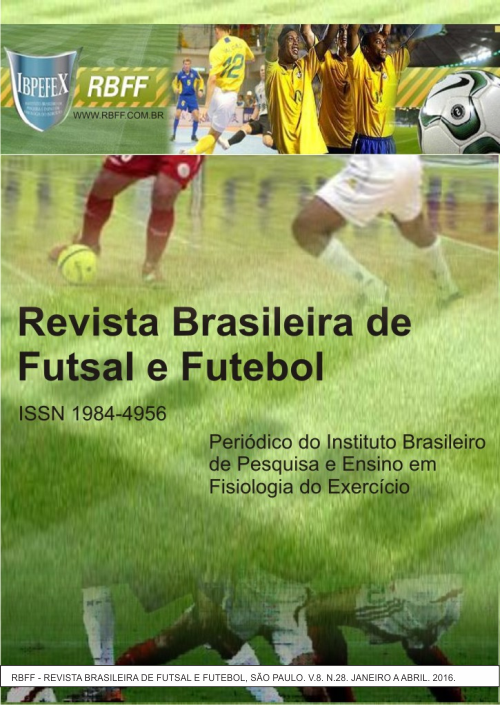Analysis of targets settings changes in the tatical behavior in a smaller and conditionated field
Abstract
The aim of this study was to investigate changes in the tactical behavior of young football players in a field of smaller dimensions, with two targets settings. The study sample was composed of 16 players from the U-17 Sport Club Juiz de Fora football team, divided into four teams of four players each who played in a field of 36 meters by 27 meters, on two different structures: i) with one goal ii) with three goals. To evaluate the tactical behavior we used the game flow, through the playing time of each player, the number of passes and the number of goals. There was no significant difference between the interventions in the total playing time between the runners, with a bigger tendency of passes occurrence when one goal was use. On the other hand the total number of goals was significantly higher in the intervention with three goals, as well as the central player tends to have a higher playing time in comparison with the side player. We found evidences that showed that the manipulation of the number of goals do not influence the game flow, but may influence tactical behavior in young players being considered an excellent training method and its application will depend on the needs of coaches.
References
-Dellal, A.; Owen, A.; Womg, D. P.; Krustrup, P.; van Exsel, M.; Mallo, J. Tecnical and physical demands of smal vs. large dided games in relation to playing position in elite soccer. Human Movement Science. Vol. 31. Num. 4. p. 957-969. 2012.
-Duarte, R.; Araújo, D.; Fernandes, O.; Travassos, B.; Folgado, H.; Diniz, A.; Davids, K. Effects of diferente practice task constrains on fluctuations of player heart rate in small-sided football games. The Open Sports Science Journal. Vol. 3. p. 13-15. 2010.
-Garganta, J.; Gréhaigne, J. F. Abordagem sistêmica do jogo de futebol: moda ou necessidade? Movimento. Vol. 5. Num. 10. p. 40-50. 1999.
-Gréhaigne, J. F.; Godbout, P. Tactical knowledge in team sports from a constructivist and cognitivist perspective. Quest. Vol. 47. Num. 4. p. 490-505. 1995.
-Grehaigne, J. F.; Bouthier, D.; David, B. Dynamic-system analysis of opponent relationships in collective actions in soccer. Journal of Sports Sciences.Vol. 15. Num. 2. p.137-149. 1997.
-Hill-Haas, S. V.; Dawson, B.; Impellizzeri, F. M.; Coutts, A. J. Psysiology of small-sided games training in football: A systematic review. Sports Medicine. Vol. 41. Num. 3. p. 199-220. 2011.
-Moura, F. A.; Martins, L. E. B.; Anido, R. D. O.;Leite de Barros, R. M.;Cunha, S. A. Quantitative analysis of Brazilian football players organization on the pitch. Sports Biomechanics. Vol. 1. Num. 11. p. 85-96. 2012.
-Newell, K. Constraints on the development of coordination. In Wade, M. G.;Whitining, H. T. A. Motor development in children: Aspects of coordination and control. Vol. 34. p. 341-360. Boston. Martinus Nijhoff. 1986.
-Tavares, F. Jogos Desportivos Coletivos: ensinar a jogar. Editora FADEUP. 2013.
-Teoldo, I.; Garganta, J.; Greco, P. J.; Mesquita, I. Princípios táticos do jogo de futebol: conceitos e aplicação. Motriz. Vol. 15. Num. 3. p. 657-668. 2009.
-Teoldo, I.; Garganta, J.; Greco, P. J.; Mesquita, I.; Maia, J. Sistema de avaliação táctica no Futebol (FUT-SAT): Desenvolvimento e validação preliminar. Motricidade. Vol. 7. Num. 1. p. 69-84. 2011.
Authors who publish in this journal agree to the following terms:
- Authors retain the copyright and grant the journal the right of first publication, with work simultaneously licensed under the Creative Commons Attribution License BY-NC which allows the sharing of the work with acknowledgment of the authorship of the work and initial publication in this journal.
- Authors are authorized to enter into additional contracts separately for non-exclusive distribution of the version of the work published in this journal (eg, publishing in institutional repository or book chapter), with acknowledgment of authorship and initial publication in this journal.
- Authors are allowed and encouraged to post and distribute their work online (eg, in institutional repositories or on their personal page) at any point before or during the editorial process, as this can bring about productive change as well as increase impact and impact. citation of published work (See The Effect of Free Access).





